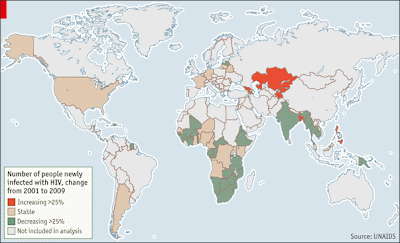Les dejo un artículo en The Economist sobre la evolución del HIV en la última década con el mapa correspondiente.
The timing of the pope’s much-discussed change of position on the use of condoms to prevent the spread of HIV (he will now allow prostitutes to use them without fear of hellfire) was surely no coincidence. He made it on November 21st—ten days before World AIDS Day and two before UNAIDS, the United Nations body charged with combating the epidemic, released its latest report on the state of the battle.
That report carries good news. Though some 33m people are infected, the rate of new infections is falling—down from 3.1m a year a decade ago to 2.6m in 2009. Moreover, as the map shows, the figure is falling fastest in many of the most heavily infected countries, especially those of sub-Saharan Africa and South and South-East Asia.
 Click para agrandar
Click para agrandarThe reason is a combination of behavioural change (people are losing their virginity later, are being less promiscuous and are using condoms more), a big reduction in mother-to-child transmission at birth and during breast-feeding, and the roll-out of drug treatment for those already infected.
Besides prolonging life, anti-HIV drugs make those taking them less likely to pass the virus on. More than 5m people in poor and middle-income countries are now on such drugs, though Michel Sidibe, the head of UNAIDS, says another 10m could benefit. (The remainder of those infected are not yet ill enough for drugs to do them good.) The problem, as always, is money. Dr Sidibe reckons the fight needs about $25 billion a year to be fully effective. At the moment, the sum spent is around $17 billion. Not a bad fraction of the desideratum, but one that will be hard to sustain in the face of the world’s economic difficulties.
Fuente: HIV´s slow retreat en The Economist.



No hay comentarios.:
Publicar un comentario